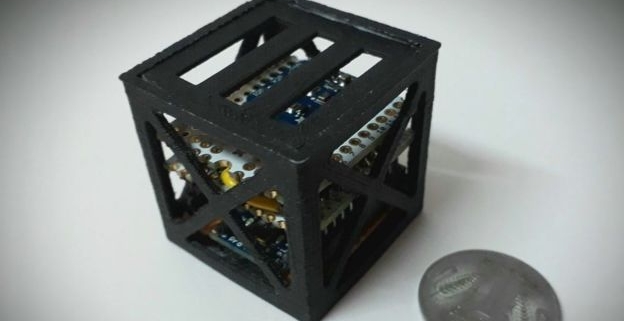ISRO Successfully Launched World’s Smallest Satellite Build by Students ‘Kalam SAT’ On Board PSLV-C44 on 24th January 2019

Nellore, January 24: The Indian Space Research Organisation (ISRO) today successfully launched the world’s lightest satellite ‘Kalamsat’ made by Indian students at 11.40 pm from the First Launch Pad (FLP) of Satish Dhawan Space Centre, Sriharikota. The communication satellite, KalamSat, is designed and built by students who work with a private organisation called “Space Kidz India.” Along with Kalamsat, the ISRO also launched Microsat-R, an imaging satellite, by the same launching vehicle. Both the satellites were launched by Polar Satellite Launch Vehicle (PSLV) in its 46th flight.
The ISRO has not charged a single rupee for the launch of Kalamsat. Speaking on the launch, ISRO Chief K Sivan said, “ISRO is open to all students of India. Bring to us your satellites and we will launch it for you. Let’s make India into a science-fairing nation.”

The Kalamsat satellite weighs just 1.26 kilogram and is lighter than a laptop. It cost Rs 12 lakh to make this satellite, and it was ready in only six days, but the group took six years to perfect the satellite. The satellite is named after Former President Dr APJ Abdul Kalam as a tribute to him. Notably, Kalamsat is the first satellite designed by an Indian Private entity to be launched by ISRO. In 2017, a 64-gram version of Kalamsat named as “Gulab Jamun” was launched by National Aeronautics and Space Administration (NASA), but it never reached the earth’s orbit.
About Kalam SAT satellite:
- Kalam SAT is named after former Indian president Dr. A. P. J. Abdul Kalam and is the world’s smallest and lightest satellite.
- The student satellite weighs just 64 grams and it is fitted in a 3.8 centimeters cube. The probe is composed of 3-D printed reinforced carbon fiber polymer. Part of the components were supplied from India and other parts from abroad.
- The satellite is built by an Indian High school student team, led by Rifath Sharook, an 18-year-old from the Tamil Nadu town of Pallapatti.
- The high school team participated in Cubes in Space, a STEM-based education program by Idoodle Learning.Inc and NASA.
- As selected student competitors, the team won an opportunity to design experiments to be launched into space on a NASA rocket.
- Kalam SAT was launched by NASA along with several other experiments on Terrier Orion sounding rocket on 22 June 2017 from Wallops Island flight facility in Virginia.
- Kalam SAT is listed in the pages of Asia Book of Records, India Book of Records and Assist World Records, as holding the record title of “World’s lightest and smallest satellite”
On Friday, while addressing a conference, Dr K Sivan, ISRO Chairman stated that the launch window for Chandravaan-2 is March 25 – April 30 this year. He said that ISRO has planned 32 missions this year. Elaborating on the priority areas of ISRO, the Chairman said that these include Gaganyaan project, reaching out to students, outreach programmes, planned missions of this year and Vikram Sarabhai Centenary celebrations. ISRO Successfully Launches India’s Heaviest and Most Powerful Satellite GSAT-11 From French Guiana; All You Need to Know.
For the first time, ISRO has announced the ‘Young Scientists Programme’ to encourage the scientific talent and increase scientific pool in the country. Under this programme, Dr Sivan said, 3 students from each state and UT will be selected for ISRO programme for one month during which they will visit ISRO centres, interact with senior scientists and will have access to Research and Development facilities, a government release stated. All the expenses of travelling and boarding will be borne by ISRO.
Meanwhile, the other satellite, Microsat-R imaging satellite of the Defence Research and Development Organisation (DRDO) weighs 700-kg. About 14 minutes into the flight the rocket would eject Microsat R at an altitude of about 277km, and it would start functioning at an altitude of 450km in about the 103rd minute after take-off. “To reduce weight and increase the mass, an aluminium tank is being used for the first time in the fourth stage,” ISRO Chairman K. Sivan had told IANS earlier. ISRO Successfully Launches India’s Heaviest and Most Powerful Satellite GSAT-11 From French Guiana; All You Need to Know.
PSLV is a four-stage launch vehicle with alternating solid and liquid stages. In its normal configuration, the rocket would have six strap-on motors. The PSLV with two strap-on configuration has been identified for this mission, and the configuration is designated as PSLV-DL. PSLV-C44 is the first mission of PSLV-DL and is a new variant of PSLV. In PSLV-C44, the fourth stage (PS4) of the vehicle will be moved to a higher circular orbit to establish an orbital platform for carrying out experiments.




Leave a Reply
Want to join the discussion?Feel free to contribute!